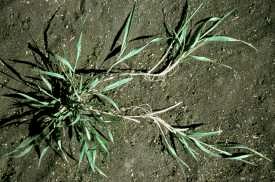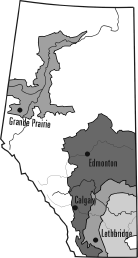| | Description | Distribution | Control | Conclusion
Quack grass (Elytrigia repens) is a competitive perennial weed. It spreads rapidly by seed or underground stems (called rhizomes) and can be difficult to control. Without control, quack grass has the potential to spread rapidly. This factsheet describes quack grass and outlines control options to reduce yield losses in direct seeded cereal and oilseed crops.
Quack grass is highly competitive with crops for water and nutrients. In trials conducted at the Alberta Research Council near Vegreville, infestations of quack grass between 5 and 9 shoots per square foot (50 and 100 shoots/m2) reduced canola yields by 18 to 32 per cent. In barley, 6 to 9 shoots per square foot (60 to 100 shoots/m2) reduced barley yields by 40 to 50 per cent.
Quack grass can serve as a 'green bridge' for cereal diseases, providing a living host for the diseases between cereal crops. Control of quack grass in broad-leaved crops can reduce the spread of leaf spot disease and ergot in subsequent cereal crops.
Description
Quack grass can reproduce by seed and vegetative rhizomes (Figure 1). Seedlings are frequently purple/brown with a hairy leaf sheath. New seedlings are weak competitors. At the 4- to 6-leaf stage, seedlings begin to produce tillers. At the 6- to 8-leaf stage, rhizome production begins. The mature plant can be 2.5 to 4.0 feet (0.75 to 1.2 m) tall.

Figure 1. Quackgrass with rhizomes and secondary plants
Quack grass is sometimes confused with smooth brome. To tell the two apart, run your fingers from the tip to the base of the leaf blade. Quack grass will feel rough while smooth brome will feel smooth. Also, smooth brome has a visible "M" impression about two-thirds of the way between the leaf blade's tip and base. Quack grass has no such marking.
Rhizomes are key to quack grass's persistence. They are scaly, yellow to white, root-like underground stems with sharply tapered ends. New shoots and fibrous roots emerge from rhizome nodes. Under direct seeding, rhizomes grow in the top 5 to 6 inches (10 to 15 cm) of soil. Over a growing season, rhizomes can spread 10 feet (3 m) from the original plant. A single seedling can produce 440 feet (135 m) of rhizome mass over a growing season. Therefore, this weed is usually found in patches. Quack grass patches can exceed densities of 17 plants/square foot (180 plants/m2).
Light, temperature and moisture influence quack grass growth. Under cool conditions (5 to 10°C), rhizome growth is enhanced, while under warmer conditions (15 to 20°C), shoot growth is enhanced. Quack grass growth does not stop after seed production but can continue into fall, as long as the ground is not frozen.
Distribution
Quack grass is common in Alberta, occurring in 18 per cent of all cereal and oilseed fields surveyed in 1997. It is most common in the cool, wet Aspen Parkland region; it is also found in the Peace Lowland, Boreal Transition, Fescue Grasslands and Moist Mixed Grasslands (Figure 2). Less than 1 per cent of the fields in the Mixed Grasslands contain quack grass.
Across the province, quack grass was most common in oat and canola fields, with 25 and 23 per cent of these fields containing quack grass, respectively, in 1997. In barley and wheat, 19 and 14 per cent of all fields, respectively, contained quack grass in 1997.
 |  |
Figure 2. Distribution of quack grass
In direct seeding systems
A Manitoba survey comparing fields under zero and conventional tillage found few differences in the frequency of quack grass between the two systems. Increased soil moisture available in the zero tillage system will favor quack grass growth. This seeming advantage is offset by the reduced mechanical spread of the weed with less tillage (tillage breaks up rhizome mats and spreads rhizomes within the field) and by effective herbicide controls.
Control
The key to both chemical and cultural control of quack grass is persistence. Because quack grass rhizomes contain dormant buds and a food supply to allow them to develop, a single treatment is not likely to be totally effective.
Control with herbicides
Various herbicides and timing options are available for quack grass control. Check the latest edition of Crop Protection Agdex 606-1 (the "Blue Book") for information on herbicide products, rates and procedures. Read and follow all product labels and directions carefully.
Post-emergent control - Chemical control options vary greatly between cereals and broad-leaved crops.
- In cereals: Control quack grass in cereal crops before seeding and use as many cultural controls as possible. In-crop controls for quack grass in cereals are limited. In wheat, Sundance and Anthem will suppress quack grass. In barley, in-crop control options are fewer.
- In broad-leaved crops: The optimal time to control quack grass is in broad-leaved crops. Use these as 'clean-up crops.' For peas and lentils, Assure II, Poast Ultra and Select are all registered for selective control of quack grass. Venture is registered for suppression in peas. In oilseed crops, including flax, canola, mustard or sunflowers, Select or Venture control quack grass. Herbicide-tolerant varieties of canola offer other options, depending on the type of canola grown, as shown in Table 1.
Pre-seeding control - Actively growing quack grass at the 3- to 4-leaf stage can be controlled with glyphosate (Roundup Original/Dry, Renegade, Victor, Roundup Transorb, Glyfos, Touchdown, Vantage, Vantage Plus)1 before seeding. Recommended Roundup Original rates range from 1.0 to 2.8ÿL/acre. Light to moderate infestations can be controlled with 1ÿL/acre. The higher rates are used for heavy infestations and for longer and more consistent control. Pre-seeding applications may not be as effective under direct seeding if cool soil temperatures slow quack grass emergence. Slower emergence can result in insufficient leaf area to accumulate the herbicide at the time of spraying.
Pre-harvest control - Pre-harvest glyphosate is generally considered the best option for perennial weed control. Roundup Original at 1 L/acre can be applied to most crops prior to harvest. For annual crops, apply when the average seed moisture content is below 30 per cent, usually one to two weeks before harvest. Do not apply if growing the crop for seed or malt.
Table 1. Herbicides for control of quack grass in canola
Canola type | Trade name | Quack grass
leaf stage | Rate | Level of control |
| Conventional | Assure II | 2 to 6 | 300 mL/acre | control |
| Select | 2 to 5 | 152 mL/acre | control |
| Poast Ultra | 1 to 3 | 445 mL/acre | control |
| Venture 25 DG | 3 to 5 | 280 g/acre | suppression |
| Smart (Clearfield) | Poast Ultra + Pursuit | 1 to 3 | 445 mL/acre + 85 mL/acre | control |
| Venture 25 + Pursuit | 3 to 5 | 280 g/acre + 85 mL/acre | suppression |
| Liberty Link | Liberty | 1 to 4 | 1080 to 1350 mL/acre | suppression to control |
| Roundup Ready | Roundup
(Transorb/Original) | 3 to 4 | 500 mL/acre | control |
Post-harvest control - Post-harvest applications of glyphosate are frequently successful, but the weeds must have three to four new leaves and be actively growing to ensure success. These characteristics ensure enough leaf area to accumulate the herbicide and ensure translocation of the herbicide to the rhizome buds in sufficient concentration to kill them.
Glyphosate is not actively absorbed or translocated when plants are under stress. At least 75 per cent of the plant must be green and actively growing for effective spraying. A light frost (-2 to -3øC) will not affect quack grass control using glyphosate, providing temperatures rise to the mid-teens during the day. Some studies have found improved control after a light frost. A heavy frost (-5øC or colder) requires at least three day's delay prior to spraying to determine if the quack grass has recovered.
Resistance - Herbicide resistance has not occurred as yet in quack grass. However, because of biotype differences, herbicide control can vary between locations. Rates may need to be modified to maximize herbicide control.
Heavy infestations - Controlling heavy infestations of quack grass requires higher herbicide rates and multiple applications. One option is as follows: in spring, spray with Roundup Original at 1.0 L/acre or higher rate when quack grass is at the 3- or 4-leaf stage; seed with a competitive crop such as barley; and apply pre-harvest glyphosate. Another option is to use split Roundup Original applications at 0.5 L/acre, but this strategy does not always give as consistent and complete control as the higher rates.
Cultural control
Cultivation, once the mainstay of conventional producers for quack grass control, has little or no value under direct seeding systems. Soil disturbance during seeding and/or fall fertilizing will break up rhizome mats and spread rhizomes within the field. In this way, new quack grass patches are initiated. Therefore, a single disturbance by itself is not likely to provide control and may even increase the size and density of quack grass patches.
Seeding early with increased seeding rates may reduce potential crop yield loss. Use of precision seed drills which place fertilizer below and to the side of the seed, limits weed access to the nutrients and gives the crop a competitive advantage.
Competitive crops, including fall rye, winter wheat and barley, often help reduce quack grass infestations, given good management and successful crop establishment.
Conclusion
Quack grass can reduce crop yields if it is not controlled. This weed is most common in the higher moisture regions of Alberta and has the potential to increase under direct seeding unless actively managed.
Effective herbicidal control options are numerous in broad-leaved crops. In canola, herbicide-tolerant varieties offer additional herbicide options. In wheat, quack grass can be suppressed with Sundance or Anthem. In-crop control options for barley are limited. Glyphosate offers pre-seeding, pre-harvest and post-harvest control options and provides the basis for limiting the expansion of quack grass.
Persistent, well-timed controls along with competitive crops are the keys to limiting yield losses from quack grass.
Prepared by:
Grant Nelson
Dr. Linda Hall
Source: Agdex 519-27. March 2000. |
|